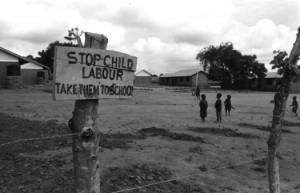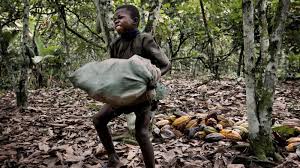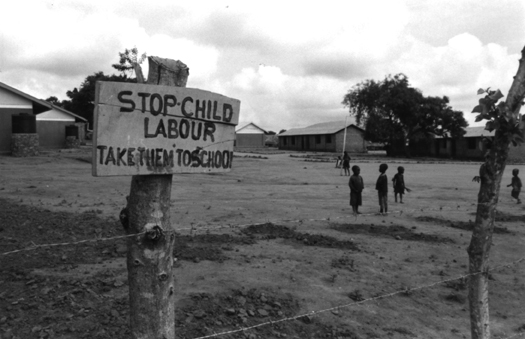Special for Africa ExPress
Simon Bouvier
Nairobi, 6th February 2014
A new certification label that aims to bring down the number of children who work to supplement their family’s income in Kenya has launched in the capital Nairobi. A joint venture between Kenya’s Ministry of Labor, Italian NGO CESVI, business associations such as the Ruaraka Business Community Association (RUBICOM) and the Central Organization of Trade Unions (COTU), the initiative revolves around a Child Labor Free Label.
 Different levels of certification are awarded to businesses in the agricultural sector that conform to the standards drawn up by CESVI, which include rehabilitating children who have worked in their supply chain by putting them back to school. According to CESVI, there are 1.1 million active child laborers across Kenya, most of them working in the agricultural sector.
Different levels of certification are awarded to businesses in the agricultural sector that conform to the standards drawn up by CESVI, which include rehabilitating children who have worked in their supply chain by putting them back to school. According to CESVI, there are 1.1 million active child laborers across Kenya, most of them working in the agricultural sector.
Speaking to Africa ExPress, Diego Ottolini — the Labor Free Zones Project Coordinator at CESVI, an Italian NGO —explained the challenges of convincing businesses that being child labor-free is as good for their bottom line as it is for Kenya’s rural youths.
Africa ExPress: Mr Ottolini, you work at CESVI and you have a project to block child labor here in Kenya you are here to talk about. Please explain how it works.
Diego Ottolini: It’s a project financed by the EU that tries to engage businesses on the subject of corporate Social responsibility. We started off with about 50 businesses and an awareness-raising project. We wanted business to switch their mindsets from charity to adhesion to international standards against child labor. We drew up these standards and presented them to these businesses. The management of this certification is done through a tripartite initiative: the government, through the Ministry of Labor, Business associations and national trade unions. These parties manage the certification with a range of inspections both inside the businesses and down the supply chain, where unfortunately most child labor is found. According to our data, there are about 1.1 million children employed in production work across the country, 35% of them in agriculture. So our targets are businesses that operate in the agricultural sector: floriculture, coffee growing…
[embedplusvideo height=”480″ width=”640″ editlink=”http://bit.ly/1kkUfZl” standard=”http://www.youtube.com/v/7hM7kSqweLo?fs=1&vq=hd720″ vars=”ytid=7hM7kSqweLo&width=640&height=480&start=&stop=&rs=w&hd=1&autoplay=0&react=1&chapters=¬es=” id=”ep5976″ /]
AE: I imagine you encounter resistance in your efforts to raise awareness with businesses and families…
DO: Yes, some businesses have trouble understanding that they have responsibilities when it comes to respecting human rights. They sometimes object: “We are not NGOs, we do not have a mandate to protect rights, especially children’s rights.” What we point out to them is that, whether they are complicit or not, these children are exploited, so their business profits from child labor. From the moment they realize this the process begins, but it’s a difficult one because of how complicated it is to trace products.
AE: What about the families? They lose income when their children stop working.
 DO: What we propose is this: instead of sponsoring families broadly, businesses assist them though specific endowments. So if children are found by a business to be at work on one of their production sites, that business sponsors education for those children. The main problem here in Kenya is poverty to which one must add all the cultural factors that lead children to work in support of their family. But nowadays there is a new cultural context according to which children must go to school in order to achieve success, which will allow children to support their family.
DO: What we propose is this: instead of sponsoring families broadly, businesses assist them though specific endowments. So if children are found by a business to be at work on one of their production sites, that business sponsors education for those children. The main problem here in Kenya is poverty to which one must add all the cultural factors that lead children to work in support of their family. But nowadays there is a new cultural context according to which children must go to school in order to achieve success, which will allow children to support their family.
AE: In your speech [at the CLFL press conference] you stated that, for equal products that cost the same, consumers choose “Child Labor Free” products over the competition. But because child labor costs less than adult labor, businesses that exploit children can sell their products cheaper, thereby undercutting “Child Labor Free” products.
DO: Things are not so obvious. In fact, labor here in Kenya is much cheaper than in Europe, so labor costs are still minimal, and don’t affect production that much. What is important is that the children be rehabilitated in the education system. That is what this initiative is about.
Simon Bouvier
simoncolasbouvier@gmail.com

